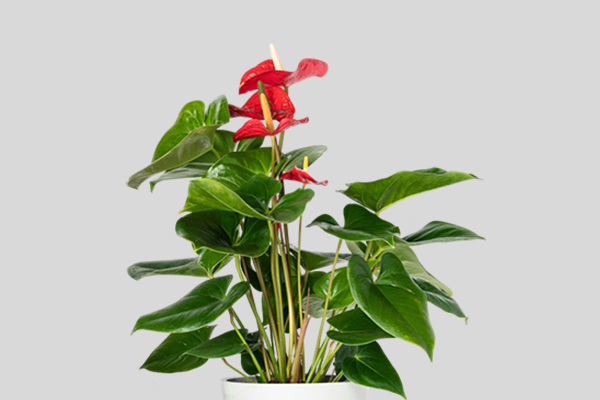
Anthurium
Anthurium is one of the most striking houseplants, valued for its glossy, vibrant leaves and unique flowers that resemble waxy hearts. Often called the “Male Happiness” plant, it is considered a symbol of strength and energy. To keep it looking decorative, it is essential to provide the right conditions and follow basic care guidelines.
Placement
Anthurium thrives in bright but indirect light. The best spots are east- or west-facing windows. On south-facing windowsills, it must be shielded from direct sunlight with a curtain or blinds to avoid leaf burn. On north-facing windows, flowering becomes rare or may stop completely due to lack of light. Anthurium is sensitive to drafts and cold air, so it should not be placed near open windows or air conditioners.
Watering
Watering should be regular but not excessive. In summer, water every 3–4 days; in winter, once a week is enough. The soil should remain slightly moist but never soggy, as standing water causes root rot. Use soft, settled water at room temperature. Anthurium also loves high humidity, so misting the leaves or placing the pot on a tray with moist pebbles is beneficial.
Feeding
During its active growth and flowering period (spring through autumn), Anthurium requires regular feeding. Fertilizers for flowering plants rich in potassium and phosphorus are ideal, applied every two weeks. In winter, during dormancy, feeding should be reduced or stopped altogether.
Repotting
Young Anthuriums are repotted annually in spring into slightly larger pots. Mature plants only need repotting every 2–3 years. The soil should be light and well-draining, with peat, conifer soil, and pieces of bark. Drainage at the bottom is essential. For large plants, replacing the topsoil may be enough.
Temperature
Anthurium prefers warmth, with an optimal range of +20…+25 °C in summer and not below +16 °C in winter. Sudden temperature drops and cold drafts are harmful. It is not frost-resistant: even a short drop below +10 °C can be fatal.
Pruning
Pruning is less critical for Anthurium compared to other plants but helps maintain its decorative appearance. Spent flowers should be cut off at the base to prevent the plant from wasting energy on seeds. Old, damaged, or yellowed leaves should also be removed. This can be done throughout the year as needed.
Conclusion
Anthurium is a striking but demanding plant that responds well to proper care. It needs a bright but protected spot, moderate watering, high humidity, regular feeding, and repotting in suitable soil. Under the right conditions, Anthurium will delight you with glossy leaves and long-lasting blooms, enhancing your home’s interior.
